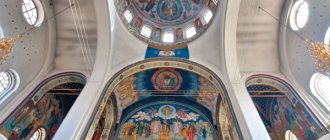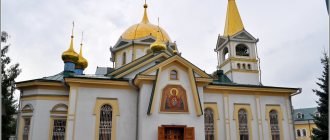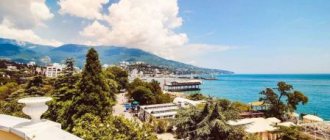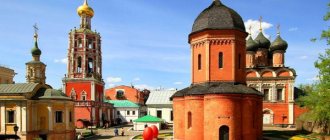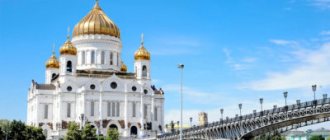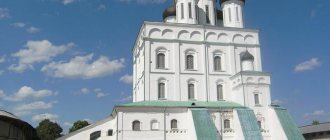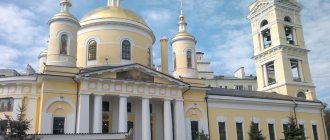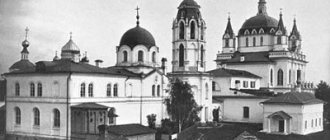Revolutionary upheavals affected the temple back in March, when, after the abdication of Emperor Nicholas II, a religious procession to St. Michael's Cathedral took place in Izhevsk to commemorate the end of autocracy; In honor of the “beginning of a new era in the history of Russia,” a thanksgiving prayer service was held.
By the end of 1918, fighting broke out near the cathedral with the Bolsheviks; the peasantry, clergy and workers of Izhevsk, on whose support the Reds relied primarily, came out against them. The Reds captured the city. According to some reports, the Bolsheviks shot many Izhevsk workers near the walls of the temple; executions also took place in other parts of the city.
The “Red Terror” unfolded in the country. In 1922, authorities seized large amounts of gold and silver from the altar of St. Michael's Cathedral.
After the transfer of the Alexander Nevsky Temple to the Renovation Church, St. Michael's Cathedral became a cathedral - for the first time in its history.
Until 1930, parishioners managed to defend the cathedral from attacks. The practice of mandatory registration and concluding agreements between authorities and parishioners that existed in those years became a vast field for bureaucratic tricks and chicanery. In April 1930, the Izhevsk City Council terminated such an agreement by force. The fate of St. Michael's Cathedral was sealed. In the spring days of 1932, all the bells were thrown off it and sent for melting down.
How to get there by public transport
The temple complex can be reached by public transport. The stop "St. Michael's Cathedral" is located on the route of tram routes No. 1, 2, 4, 9, 10. From this stop to the cathedral it is only about 170 m.
Near the temple there are:
- buses No. 6, 7, 9, 11, 12, 19, 26, 27, 28, 36, 39, 40, 41, 56;
- trolleybuses No. 1, 4, 4d, 6, 6d, 7, 7d, 9;
- minibus No. 10, plying the route “Stankostroy - Plastics Plant”.
You should focus on the following stops (they are located from the cathedral at a distance of 300 to 700 m):
- TSUM;
- DK "Axion";
- Dynamo Stadium;
- Central square;
- Park named after Gorky;
- Cinema "Friendship";
- Alexander Nevsky Cathedral;
- Lenin.
History of the temple
St. Michael's Cathedral (Izhevsk) has a rich history. It was built on the site of the Trinity Chapel, which was once erected on an old factory cemetery. In 1784, on the site of the chapel, the Church of the Holy Trinity was built, which in 1810 was destroyed by a large fire.
The construction of a new temple was delayed for many years, since several churches already existed in the city. Therefore, in 1855, a large stone chapel was built on an empty site.
It was erected in honor of Archangel Michael, a saint especially revered by the residents of Izhevsk and the patron saint of Grand Duke Mikhail Pavlovich Romanov. The structure was made in the Byzantine style and reached a height of 30 m.
However, the factory village needed a temple. Therefore, in 1876, residents organized a fundraiser that would allow construction of a new temple building to begin.
From 1896 to 1897 All design work was completed, the author of which was the architect Ivan Apollonovich Charushin, who managed to insist on his point of view and design the building not in the Byzantine, but in the Russian style of St. Basil's Cathedral.
In 1897, the foundation stone of a new temple took place. Major construction work continued for 10 years. As a result, a majestic 9-domed cathedral was erected, visible from a distance of 20 km, and the chime of its 11 bells (the largest weighed 2.5 tons) was heard far in the area.
Its construction cost 350 thousand rubles, which was quite a large sum. In November 1907, the main altar was consecrated in the new church in the name of St. Michael, and the first service was held.
For some time, the temple served as a non-parish factory church and was assigned to the Alexander Nevsky Cathedral. An independent parish was opened only in 1917.
: St. Michael's Cathedral in Izhevsk
However, after the October Revolution, St. Michael's Cathedral suffered the fate that befell most religious buildings : already in March 1929 it was closed and sealed, in the spring of 1932 it lost its bells, and in 1933 it was converted into a local history museum.
Bolsheviks were buried in front of the cathedral, and several Vodokanal buildings were built on the site of the ancient cemetery, as a result of which the old burial places were destroyed. But this was not enough. In April 1937, based on orders from Moscow, local authorities decided to completely destroy the amazingly beautiful building.
Soviet period
In 1922, the communists confiscated all valuables from the Nevsky Cathedral (Izhevsk). In 1929, the temple was robbed again and finally closed. The building housed a club and a museum of atheism. Later, reconstruction was carried out and the children's cinema "Colossus" was opened.
As a result, unique wall paintings and most of the icons were lost forever. The iconostasis was completely destroyed and the domes were dismantled. Only in 1990 did the revival of the temple begin. One of the most beautiful cathedrals in Izhevsk has been restored and re-painted.
The re-consecration of the temple took place in the winter of 1994. The working schedule of the Nevsky Cathedral (Izhevsk) can be viewed on the official website of the Udmurt diocese.
Address: st. M. Gorky, 66.
Modern life of the temple
For more than 60 years the temple stood in ruins. The idea of reviving the cathedral arose back in 1989. But only in February 2000, thanks to the initiative of the President of Udmurtia A. A. Volkov, it was decided to restore this historical monument. Construction work began in 2004 (immediately after the religious procession that took place on May 19).
It took 3 years to revive the cathedral (the opening was timed to coincide with the 100th anniversary). Already in May 2007, the lower church, erected in honor of Faith, Hope, Love and their mother Sophia, was restored and consecrated, and in August 2007, the throne of St. Michael was consecrated and the first liturgy after the restoration took place.
Serious public work is carried out at the cathedral. Now St. Michael's Church is a center for religious and cultural education, charity and community service. The temple has a choir school, an exhibition gallery, and a teaching and learning center. There are also regular excursions organized by the tour service.
For children of all ages, the cathedral has been operating a Sunday school for more than 10 years. At the end of the year, pilgrimage trips to both distant and nearby monasteries are organized for school students and their parents.
At the temple there is a school of icon painting “Stavros”, where you can get acquainted with the basics of this ancient craft and, if you wish, purchase your favorite work as a keepsake. The school was opened at the temple back in 2008.
It is headed by Vasily Nikolaevich Morozov, Honored Artist of the Udmurt Republic. A serious approach to teaching has allowed us to achieve great success: Stavros graduates are often invited to paint temples.
By decree of His Holiness Patriarch Kirill of Moscow and All Rus' in July 2021, St. Michael’s Church was given the status of a cathedral.
The modern St. Michael's Cathedral is the pride of Udmurtia
The modern St. Michael's Cathedral is the hallmark of Izhevsk. Standing on the highest point of the city, the temple is visible from anywhere. The restored complex immediately became a favorite place for the townspeople; not only spiritual, but also a variety of cultural, historical, and folk events are held on its territory.
On a note! Newlyweds are attracted by the monument to Peter and Fevronia, erected not far from the magnificent Orthodox building. It is considered a special blessing on the wedding day to lay flowers and pray at the monument to the couple who won their love and carried it through their entire lives.
The monument to the Saints of Murom was restored according to the Russian program “In the Family Circle”, which was blessed by Patriarch Alexy II of Moscow and All Rus'. The purpose of this program is to strengthen family values, revive pure premarital relations, chastity and obedience of children to their parents. The area of the Mikhailovsky complex, often visited by city residents, is a good place for a monument to love and Christian values.
Monument to Saints Peter and Fevronia near the cathedral
Currently, the attitude towards family values is a sore point in society, and only the church can solve it. The priests of St. Michael's Shrine do everything to strengthen the family. The monument was consecrated by Metropolitan Nicholas of Izhevsk and Udmurtia.
Interesting! Every year, couples celebrating their 25th anniversary of marriage are awarded medals “For Love and Fidelity” on the threshold of their silver wedding.
Architect and exterior decoration of the cathedral
The architect E. L. Skopin was involved in recreating the original appearance of the building. The cathedral, reaching a height of 67 m (the size of a 22-story building), is magnificent from any point of view.
This effect is achieved by maintaining symmetry along the vertical axis (that is, there is practically no emphasis on the front and rear courtyard facades). An architectural feature is the placement of the lower temple on the ground floor.
The basis of the building is formed by 8 turrets and 9 large chapters. As in the original project, 4 of them contain bells (there are 11 in total). For the revived temple, they were cast using traditional technologies by craftsmen from Voronezh.
There are crosses on the cathedral. The largest one, which adorned the destroyed building, reached 4 m. The restored temple is now crowned with a 7-meter cross.
The architectural stucco covering the entire building and the many façade elements that decorate the arched windows and kokoshniks add elegance and lightness to the exterior appearance. The elegance of the figured masonry is achieved through the use of patterned bricks.
The magnificent structure delights visitors not only during the day, but also at night. For night viewing, a special lighting system has been developed, which further emphasizes the beauty and grandeur of the cathedral.
An excerpt characterizing the Cathedral of the Holy Archangel Michael (Izhevsk)
- No, look what a moon it is!... Oh, how lovely! Come here. Darling, my dear, come here. Well, do you see? So I would squat down, like this, I would grab myself under the knees - tighter, as tight as possible - you have to strain. Like this! - Come on, you'll fall. There was a struggle and Sonya’s dissatisfied voice: “It’s two o’clock.” - Oh, you're just ruining everything for me. Well, go, go. Again everything fell silent, but Prince Andrei knew that she was still sitting here, he sometimes heard quiet movements, sometimes sighs. - Oh my god! My God! what is this! – she suddenly screamed. - Sleep like that! – and slammed the window. “And they don’t care about my existence!” thought Prince Andrei as he listened to her conversation, for some reason expecting and fearing that she would say something about him. - “And there she is again! And how on purpose!” he thought. In his soul suddenly arose such an unexpected confusion of young thoughts and hopes, contradicting his whole life, that he, feeling unable to understand his condition, immediately fell asleep. The next day, having said goodbye to only one count, without waiting for the ladies to leave, Prince Andrei went home. It was already the beginning of June when Prince Andrei, returning home, again drove into that birch grove in which this old, gnarled oak had struck him so strangely and memorably. The bells rang even more muffled in the forest than a month and a half ago; everything was full, shady and dense; and the young spruces, scattered throughout the forest, did not disturb the overall beauty and, imitating the general character, were tenderly green with fluffy young shoots. It was hot all day, a thunderstorm was gathering somewhere, but only a small cloud splashed on the dust of the road and on the succulent leaves. The left side of the forest was dark, in shadow; the right one, wet and glossy, glistened in the sun, slightly swaying in the wind. Everything was in bloom; the nightingales chattered and rolled, now close, now far away. “Yes, here, in this forest, there was this oak tree with which we agreed,” thought Prince Andrei. “Where is he,” Prince Andrei thought again, looking at the left side of the road and without knowing it, without recognizing him, he admired the oak tree that he was looking for. The old oak tree, completely transformed, spread out like a tent of lush, dark greenery, swayed slightly, swaying slightly in the rays of the evening sun. No gnarled fingers, no sores, no old mistrust and grief - nothing was visible. Juicy, young leaves broke through the tough, hundred-year-old bark without knots, so it was impossible to believe that this old man had produced them. “Yes, this is that same oak tree,” thought Prince Andrei, and suddenly an unreasonable, spring feeling of joy and renewal came over him. All the best moments of his life suddenly came back to him at the same time. And Austerlitz with the high sky, and the dead, reproachful face of his wife, and Pierre on the ferry, and the girl excited by the beauty of the night, and this night, and the moon - and all this suddenly came to his mind. “No, life is not over at the age of 31, Prince Andrei suddenly finally, permanently decided. Not only do I know everything that is in me, it is necessary for everyone to know it: both Pierre and this girl who wanted to fly into the sky, it is necessary for everyone to know me, so that my life does not go on for me alone So that they don’t live so independently of my life, so that it affects everyone and so that they all live with me!” Returning from his trip, Prince Andrei decided to go to St. Petersburg in the fall and came up with various reasons for this decision. A whole series of reasonable, logical arguments why he needed to go to St. Petersburg and even serve were ready at his service every minute. Even now he did not understand how he could ever doubt the need to take an active part in life, just as a month ago he did not understand how the thought of leaving the village could have occurred to him. It seemed clear to him that all his experiences in life would have been in vain and would have been meaningless if he had not applied them to action and taken an active part in life again. He did not even understand how, on the basis of the same poor reasonable arguments, it had previously been obvious that he would have humiliated himself if now, after his life lessons, he again believed in the possibility of being useful and in the possibility of happiness and love. Now my mind suggested something completely different. After this trip, Prince Andrei began to get bored in the village, his previous activities did not interest him, and often, sitting alone in his office, he got up, went to the mirror and looked at his face for a long time. Then he turned away and looked at the portrait of the deceased Lisa, who, with her curls whipped up a la grecque [in Greek], tenderly and cheerfully looked at him from the golden frame. She no longer spoke the same terrible words to her husband; she simply and cheerfully looked at him with curiosity. And Prince Andrei, clasping his hands back, walked around the room for a long time, now frowning, now smiling, reconsidering those unreasonable, inexpressible in words, secret as a crime thoughts associated with Pierre, with fame, with the girl on the window, with the oak tree, with female beauty and love that changed his whole life. And at these moments, when someone came to him, he was especially dry, strictly decisive and especially unpleasantly logical. “Mon cher, [My dear,],” Princess Marya would say when entering at such a moment, “Nikolushka can’t go for a walk today: it’s very cold.” “If it were warm,” Prince Andrei answered his sister especially dryly at such moments, “then he would go in just a shirt, but since it’s cold, we need to put warm clothes on him, which were invented for this purpose.” This is what follows from the fact that it’s cold, and not like staying at home when the child needs air,” he said with particular logic, as if punishing someone for all this secret, illogical inner work that was happening in him. Princess Marya thought in these cases about how this mental work dries out men. Prince Andrey arrived in St. Petersburg in August 1809. This was the time of the apogee of the glory of the young Speransky and the energy of the revolutions he carried out. In this very August, the sovereign, while riding in a carriage, fell out, injured his leg, and remained in Peterhof for three weeks, seeing daily and exclusively with Speransky. At this time, not only two so famous and alarming decrees were being prepared on the abolition of court ranks and on examinations for the ranks of collegiate assessors and state councilors, but also an entire state constitution, which was supposed to change the existing judicial, administrative and financial order of government of Russia from the state council to the volost board. Now those vague, liberal dreams with which Emperor Alexander ascended the throne were being realized and embodied, and which he sought to realize with the help of his assistants Chartorizhsky, Novosiltsev, Kochubey and Strogonov, whom he himself jokingly called comite du salut publique. [Committee of Public Safety.] Now everyone has been replaced by Speransky on the civil side and Arakcheev on the military side. Prince Andrei, soon after his arrival, as a chamberlain, came to the court and left. The Tsar, having met him twice, did not honor him with a single word. It always seemed to Prince Andrei that he was antipathetic to the sovereign, that the sovereign was unpleasant about his face and his whole being. In the dry, distant look with which the sovereign looked at him, Prince Andrei found confirmation of this assumption even more than before. The courtiers explained to Prince Andrey the sovereign's lack of attention to him by the fact that His Majesty was dissatisfied with the fact that Bolkonsky had not served since 1805. “I myself know how much we have no control over our likes and dislikes,” thought Prince Andrei, and therefore there is no need to think about personally presenting my note on the military regulations to the sovereign, but the matter will speak for itself.” He conveyed his note to the old field marshal, a friend of his father. The field marshal, having appointed an hour for him, received him kindly and promised to report to the sovereign. A few days later it was announced to Prince Andrey that he had to appear before the Minister of War, Count Arakcheev.
Architectural ensemble of the cathedral
St. Michael's Cathedral (Izhevsk) is not one building, but a whole temple complex. The area around the cathedral is decorated with green lawns, beautiful flower beds, and bronze sculptures. The most famous of them can be called the monument to the faithful Peter and Fevronia of Murom.
There is also a memorial erected here in memory of the victims of the civil war, which was designed by the architect F. Senatov. The monument was dedicated to the Red Army soldiers who died during the Izhevsk-Votkinsk uprising of 1918.
The structure was damaged during the construction of the temple, but it was restored and left on the territory of the cathedral. This was done as a sign of respect for the country's controversial history.
On July 7, 2011, another attraction was opened near the cathedral - the “Bench of Reconciliation” in a beautiful forged frame.
The presentation took place on the eve of the Day of Family, Loyalty and Love, since the bench is intended to reconcile people who are in a quarrel. Its special concave shape helps to do this, bringing quarreling people closer together. For those who want to visit this attraction in the evening or at night, there is a lantern above the bench.
In addition to the prayer rooms, the complex also includes:
- Cathedral of the Kazan Icon of the Mother of God;
- a beautiful chapel in memory of the holy saints Peter and Fevronia;
- walk-through gallery;
- Jordan;
- exhibition gallery;
- church shop.
Cathedral of the Kazan Icon of the Mother of God
Due to the fact that the cathedral is located on a hill, you can reach its entrance along the wide main staircase, which is also part of the temple complex.
If in the warm season the area around the cathedral is decorated with greenery, then in winter you can admire the ice sculptures that are created by craftsmen especially for the parishioners of the temple and guests.
In addition, 6 more chapels are assigned to St. Michael’s Church:
- St. Nicholas (train station);
- Our Lady of Help in Childbirth (maternity hospital No. 6);
- Russian New Martyrs (Pension Fund);
- Holy Martyr Bonifatius (drug dispensary);
- as well as the Holy Martyr Svetlana on the Pond and the Holy Great Martyr Catherine (“Izhmash”).
Current state
The cathedral was rebuilt and restored between 2004 and 2007. Today it is a whole temple complex, which, in addition to St. Michael’s Cathedral, includes the Kazan Church, the Chapel of Peter and Fevronia, a cemetery, Jordan and a bypass gallery - a walkway. Lawns are laid out throughout the territory and bronze sculptures are installed.
The cathedral is made in the Russian-Byzantine style. Unlike other Izhevsk churches, it does not have a front facade and looks the same from any vantage point. Today, having overcome all difficulties, the cathedral delights the townspeople and guests of Izhevsk with its splendor.
Address: st. Karl Marx, no. 222.
Interior decoration
The interior decoration is luxurious and amazes with its richness and splendor. As in previous times, 4 thrones were restored: three in the upper temple and 1 in the lower.
Thrones of the upper temple:
- Archangel Michael;
- Martyr Alexandra;
- Nicholas of Myra.
In the lower church there is a chapel of Saints Faith, Hope, Love and their mother Sophia.
It is interesting that the wall painting of the Cathedral of Christ the Savior in Moscow was taken as the basis for the wall painting. The work was carried out by artists from Palekh, led by I. Lebedev. Nizhny Novgorod craftsmen from Dzerzhinsk were invited to create a new carved iconostasis.
In the lower church there is a unique iconostasis made of faience - the only one in the republic. It was created by Ural craftsmen.
Patronal holidays[edit]
Michael, Archangel
— September 19 (memory of the miracle in Khoneh), November 21 (cathedral)
Faith, Hope, Love, holy martyrs
— September 30 (House church in the monastery courtyard in the village of Vartemyagi, Vsevolozhsk district, Leningrad region)
Nicholas the Wonderworker, Archbishop of Myra, Saint
— May 22, December 19
Alexandra of Rome, martyr, empress
- the 6th of May
Shrines and relics of the temple
St. Michael's Cathedral (Izhevsk) is not only beautiful, but is also the custodian of a large number of religious shrines. There are unique icons here.
The cathedral contains particles of relics:
- Anna (mother of the Virgin Mary);
- Nicholas the Wonderworker;
- Matrona of Moscow.
Icons (many of them also contain particles of holy relics):
- St. Panteleimon;
- St. Luka Krymsky;
- Sergius of Radonezh;
- "All Saints";
- “Savior Not Made by Hands”;
- St. Spyridon of Trimifuntsky;
- John the Baptist "Angel of the Desert".
Icons of the Mother of God:
- "Iverskaya";
- "Inexhaustible Chalice";
- "Feodorovskaya";
- "The Tsaritsa";
- "Kazanskaya";
- "Assistant in childbirth."
Among the shrines of the cathedral are two more temple icons (Archangel Michael and St. Faith, Hope, Love and their mother Sophia), as well as a stone brought from the place of death of the Apostle Simon the Canaanite, and a stone from Golgotha with a crucifix.
Service schedule, operating hours
St. Michael's Cathedral in the city of Izhevsk is active, open every day from 7.00 to 19.30. Divine services are conducted in Church Slavonic.
Service schedule:
| Day of the week | Time | Divine service |
| Every day except Thursday and holidays | 7.40 | Confession, divine liturgy, prayer service, memorial service |
| 17.00 | Vespers, Matins | |
| Thursday | 7.40 | Confession, divine liturgy, prayer service, memorial service |
| 17.00 | Akathist to Saint Nicholas (before the relics of the saint) |
Opening hours of St. Michael's Cathedral in Izhevsk
The chapel is open every day from 7 am to 7 pm. It should be noted that the morning service begins at seven in the morning and only at 10 in the morning it comes to an end, but as for the evening service, in order to attend it you need to be within the walls of the temple already at 4:30 in the evening.
However, you need to remember that a fairly large number of parishioners come to both morning and evening services, regardless of whether it is a weekend or a weekday, and sometimes the prayer service is crowded.
Therefore, for those who want to visit the chapel for the first time and just want to enjoy the grandeur and beauty of this place, as well as slowly explore its shrines, then the best time to visit the chapel will be lunch (from approximately 13:00 to 15:00), so how exactly during these few hours the temple becomes a little freer.
Interesting facts about the cathedral
The cathedral has been restored to its historical location. However, there was a high probability that instead of a temple building, a weapons museum named after M. T. Kalashnikov, a world-famous designer of small arms and a native resident of Izhevsk, could be built here.
Mikhail Timofeevich considered this decision of the authorities to be fundamentally wrong and expressed his categorical disagreement. This noble act made it possible to restore historical justice and revive St. Michael's Cathedral in its rightful place.
Information for visitors
The cathedral provides various services for parishioners and guests, and you can also buy souvenirs with religious symbols here.
Services
Services:
- On Thursdays, for parishioners who want to learn more about Orthodoxy, spiritual conversations with the clergy are held in the cathedral at 6 p.m. Anyone can visit them (for information by phone: (3412) 51-01-77).
- In the temple it is possible to order wedding rites, baptism, unction, and also prepares for the sacraments of baptism and wedding.
- Every day (by agreement) from 11.00 to 16.00 excursions are held around the St. Michael the Archangel Cathedral, during which those who wish are allowed to climb the belfry of the Kazan-Virgin Church. Touring the cathedral is free, but a donation can be made if desired. To get on one of these excursions, which are conducted for groups of 10 people or more, you must pre-register by calling or6.
Church shop
The cathedral is almost always crowded. To calmly admire all the beauty of the interior decoration, it is better to come here in the afternoon (from approximately 13.00 to 15.00).
Gifts or souvenirs can be purchased in the church shop, located on the ground floor of the cathedral building. A variety of religious items are sold here: icons (including handmade ones), jewelry, utensils, beautifully designed genealogical books intended to record the history of a family, and children's literature.
Also on sale are watches decorated with Christian symbols, and special clothing specifically designed for bathing in the Epiphany Font.
In the church shop you can purchase gift certificates for your loved ones in denominations of 1 thousand, 3 thousand and 5 thousand rubles. This certificate allows you not only to pay for purchases offered in the store, but also for baptismal and wedding ceremonies.
Izhevsk is an interesting tourist destination. The city has many noteworthy historical and modern places, but St. Michael's Cathedral is the main attraction, clearly visible to everyone entering the city. Beautiful, majestic, it has become one of the most recognizable symbols of Izhevsk, personifying a new stage in the revival of Orthodoxy on Udmurt soil.
Author: Irina Zhuravka
Alexander Nevsky Cathedral
The model for its construction was the Cathedral of St. Andrew the First-Called in Kronstadt. The Nevsky Temple was erected under the leadership of the architect S. Dudin in 1823.
The majestic cathedral building is designed in the style of strict Russian classicism. The cube-shaped structure is covered with a round drum vault. The spreader is supported by four powerful supports with smoothed corners.
Initially, the cathedral was decorated in a restrained style, but in 1870 its interiors became more pompous. The craftsmen gilded the stucco moldings, architectural elements, domes and iconostasis.
Nevsky Temple was considered the main cathedral of Izhevsk for a long time. Several churches and chapels were assigned to it. Including St. Michael's Cathedral.
